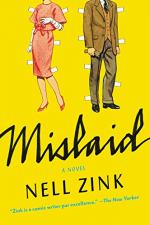|
This section contains 632 words (approx. 2 pages at 400 words per page) |

|
Mislaid Summary & Study Guide Description
Mislaid Summary & Study Guide includes comprehensive information and analysis to help you understand the book. This study guide contains the following sections:
This detailed literature summary also contains Quotes and a Free Quiz on Mislaid by Nell Zink.
“Mislaid” is an historical social novel by Nell Zink which follows the lives of a married homosexual couple, the lesbian Peggy and the gay Lee, and their children over the course of three decades. When the novel begins, Peggy Villaincourt is a 17-year-old freshman at Stillwater College in Virginia. A lesbian, she unsuccessfully pursues other girls until she meets Lee Fleming, a professor and famous poet eight years older than she is. Lee is a closeted gay, and finds it strange that he is attracted to Peggy. He imagines this must be because she is much more like a boy than other girls, and considers that maybe he has simply been pursuing the wrong kind of girl. Peggy, likewise, finds herself taken aback by how much she enjoys Lee’s masculinity, and his being in control. She considers that the manly qualities she has been looking for in women she has found in a man.
The two begin having sex frequently, during which time Peggy becomes pregnant. The two get married, but their romance quickly wears off as both realize their homosexuality is unavoidable. Nevertheless, they ultimately have two children – a boy named Rhys Byrd “Byrdie” Fleming, and a girl named Mireille, nicknamed “Mickey”. Lee and Peggy become antagonistic toward one another as Peggy’s dreams of education and becoming a famous writer lose out to being a wife and mother, while Lee becomes emotionally controlling and demanding. Eventually, Peggy has enough and leaves Lee. She takes the 4-year-old Mireille with her. They assume the identities of black people in the backwaters of Virginia to avoid Lee. Peggy takes on the name Meg, while Mireille is given the name “Karen” and the birth certificate of a dead black girl Peggy steals from the records office.
Lee and his family hire private detectives to find Peggy and Mireille, but the most ever discovered is that their names have been changed. Meanwhile, Byrd and now-Karen are raised in two completely different ways. Karen is driven to succeed based on merit and academics, while Byrd enjoys being brought up in southern white culture at the end of its era. Byrd ends up railing against his own while still enjoying the benefits of being rich, while Karen refuses to allow her circumstances to affect her future. She works harder. While Byrd goes through a series of girlfriends, dabbles in drugs, and works to improve himself academically, Karen begins seriously dating her best friend, a black boy named Temple, refuses any and all drugs, and gains access to college through scholarships. Meanwhile, Lee continues to work at Stillwater, baffled by the social and cultural changes that range from feminism to antagonism toward whites. Meg commits to dealing drugs to survive, and ends up doing them as well. She falls in love with a feminist professor of women’s studies.
While a senior in college, Byrd’s fraternity hosts a Halloween party in which alcohol and drugs are involved. Temple and Karen attend. Both pass out drunk. Other kids in Byrd’s sorority prepare to gang-rape Karen, but Byrd stops them, sensing something familiar and kind about Karen. He brings her safely back to her dorm. However, an informant in the fraternity, along with a sting operation seeking to make it appear as though the Democrat mayor is as interested in targeting white criminal youths as well as black criminal youths, causes the prosecution to go after Byrd. As a result, Byrd, Karen, and their parents are forced into court, where they all recognize one another within seconds. Meg tries to rush away, but Temple stops her. Meg, Lee, Byrd, and Karen go out to get dinner together. Over dinner, they discuss the past, and how they all want to move on beyond it.
Read more from the Study Guide
|
This section contains 632 words (approx. 2 pages at 400 words per page) |

|



